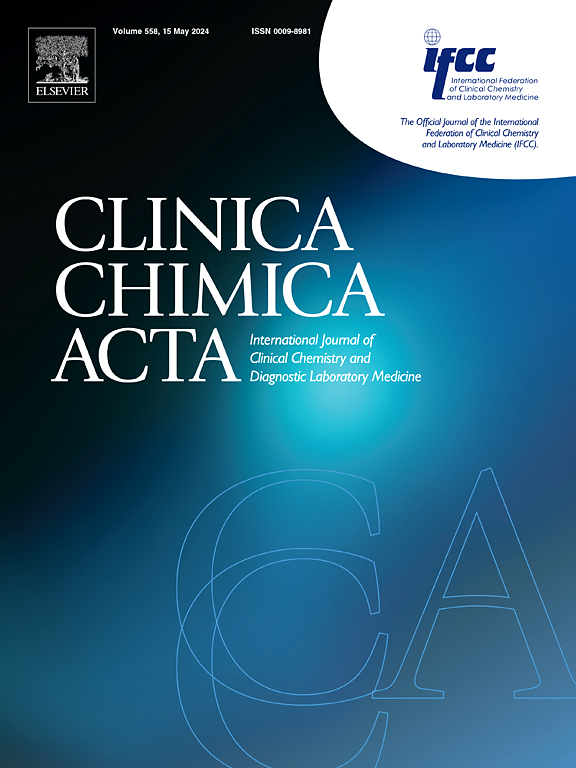微rna横向流动检测技术的最新进展。
IF 3.2
3区 医学
Q2 MEDICAL LABORATORY TECHNOLOGY
引用次数: 0
摘要
横向流动测定法(LFAs)已成为快速可靠检测microrna (mirna)的关键工具。人们认为,这些生物标志物对各种疾病,特别是癌症的诊断和预后至关重要。传统的miRNA检测技术,如定量PCR,灵敏度高,但由于其复杂性、高成本和技术要求,效果有限。lfa的价值在于它们的简单性、可负担性和可移植性,使它们成为低资源环境中护理点测试的理想选择。然而,在开发用于miRNA检测的高灵敏度和精确的LFA设备方面仍然存在挑战。本文综述了LFAs在提高miRNA检测灵敏度和特异性方面的最新进展。关键的创新包括使用等温方法的信号放大,CRISPR (Clustered Regularly Interspaced Short Palindromic Repeats)/Cas系统直接靶向miRNAs的应用,以及纳米材料(如金纳米颗粒和纳米棒)的结合,以增强信号强度。使用人工智能(AI)算法可以精确、自动和快速地定量mirna。此外,本综述还研究了基于lfa的设备同时检测多个mirna的能力。最重要的进步之一是在10分钟内检测到低至20 pM的miR-21水平和低至40 pM的let-7a水平。这凸显了这些设备在临床诊断方面的潜力。本文章由计算机程序翻译,如有差异,请以英文原文为准。
Recent advances in lateral flow assays for MicroRNA detection
Lateral flow assays (LFAs) have emerged as pivotal tools for the rapid and reliable detection of microRNAs (miRNAs). It is believed that these biomarkers are crucial for the diagnosis and prognosis of various diseases, particularly cancer. Traditional miRNA detection techniques, such as quantitative PCR, are highly sensitive but have limited efficacy due to their complexity, high cost, and technical requirements. LFAs are valuable due to their simplicity, affordability, and portability, making them ideal for point-of-care testing in low-resource environments. However, challenges remain in developing highly sensitive and accurate LFA devices for miRNA detection. This review explores recent advancements in LFAs to improve miRNA detection sensitivity and specificity. Key innovations include signal amplification using isothermal methods, the application of CRISPR (Clustered Regularly Interspaced Short Palindromic Repeats)/Cas systems for direct targeting of miRNAs, and the incorporation of nanomaterials, such as gold nanoparticles and nanorods, to enhance signal intensity. Using artificial intelligence (AI) algorithms enables precise, automated, and rapid quantification of miRNAs. Moreover, this review examines the ability of LFA-based devices to detect multiple miRNAs simultaneously. One of the most significant advancements is the detection of miR-21 levels as low as 20 pM and let-7a levels as low as 40 pM within ten minutes. This highlights the potential of these devices for clinical diagnostics.
求助全文
通过发布文献求助,成功后即可免费获取论文全文。
去求助
来源期刊

Clinica Chimica Acta
医学-医学实验技术
CiteScore
10.10
自引率
2.00%
发文量
1268
审稿时长
23 days
期刊介绍:
The Official Journal of the International Federation of Clinical Chemistry and Laboratory Medicine (IFCC)
Clinica Chimica Acta is a high-quality journal which publishes original Research Communications in the field of clinical chemistry and laboratory medicine, defined as the diagnostic application of chemistry, biochemistry, immunochemistry, biochemical aspects of hematology, toxicology, and molecular biology to the study of human disease in body fluids and cells.
The objective of the journal is to publish novel information leading to a better understanding of biological mechanisms of human diseases, their prevention, diagnosis, and patient management. Reports of an applied clinical character are also welcome. Papers concerned with normal metabolic processes or with constituents of normal cells or body fluids, such as reports of experimental or clinical studies in animals, are only considered when they are clearly and directly relevant to human disease. Evaluation of commercial products have a low priority for publication, unless they are novel or represent a technological breakthrough. Studies dealing with effects of drugs and natural products and studies dealing with the redox status in various diseases are not within the journal''s scope. Development and evaluation of novel analytical methodologies where applicable to diagnostic clinical chemistry and laboratory medicine, including point-of-care testing, and topics on laboratory management and informatics will also be considered. Studies focused on emerging diagnostic technologies and (big) data analysis procedures including digitalization, mobile Health, and artificial Intelligence applied to Laboratory Medicine are also of interest.
 求助内容:
求助内容: 应助结果提醒方式:
应助结果提醒方式:


